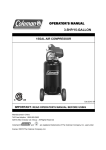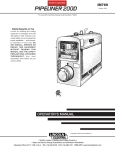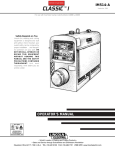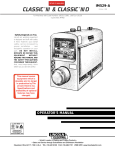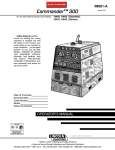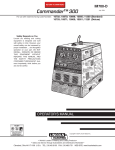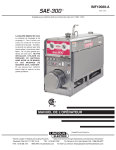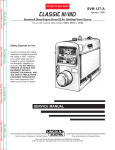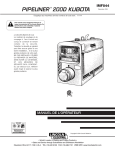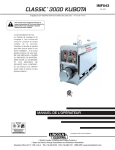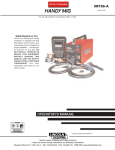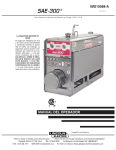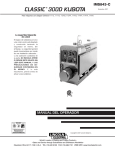Download Lincoln Electric CLASSIC IM553-C User's Manual
Transcript
CLASSIC™ II
IM553-C
DC ARC WELDER WITH DEUTZ F3L-1011F ENGINE
July, 2003
For use with machines having Code Numbers 10219, 10219CV, 10220, 10220CV, 10628, 10629,10872 and 10910
RETURN TO MAIN MENU
Safety Depends on You
Lincoln arc welding and cutting
equipment is designed and built
with safety in mind. However, your
overall safety can be increased by
proper installation ... and thoughtful operation on your part. DO
NOT INSTALL, OPERATE OR
REPAIR THIS EQUIPMENT
WITHOUT READING THIS
MANUAL AND THE SAFETY
PRECAUTIONS CONTAINED
THROUGHOUT. And, most
importantly, think before you act
and be careful.
OPERATOR’S MANUAL
Copyright © 2003 Lincoln Global Inc.
• World's Leader in Welding and Cutting Products •
• Sales and Service through Subsidiaries and Distributors Worldwide •
Cleveland, Ohio 44117-1199 U.S.A. TEL: 216.481.8100 FAX: 216.486.1751 WEB SITE: www.lincolnelectric.com
i
i
SAFETY
WARNING
CALIFORNIA PROPOSITION 65 WARNINGS
Diesel engine exhaust and some of its constituents
are known to the State of California to cause cancer, birth defects, and other reproductive harm.
The Above For Diesel Engines
The engine exhaust from this product contains
chemicals known to the State of California to cause
cancer, birth defects, or other reproductive harm.
The Above For Gasoline Engines
ARC WELDING CAN BE HAZARDOUS. PROTECT YOURSELF AND OTHERS FROM POSSIBLE SERIOUS INJURY OR DEATH.
KEEP CHILDREN AWAY. PACEMAKER WEARERS SHOULD CONSULT WITH THEIR DOCTOR BEFORE OPERATING.
Read and understand the following safety highlights. For additional safety information, it is strongly recommended that you
purchase a copy of “Safety in Welding & Cutting - ANSI Standard Z49.1” from the American Welding Society, P.O. Box
351040, Miami, Florida 33135 or CSA Standard W117.2-1974. A Free copy of “Arc Welding Safety” booklet E205 is available
from the Lincoln Electric Company, 22801 St. Clair Avenue, Cleveland, Ohio 44117-1199.
BE SURE THAT ALL INSTALLATION, OPERATION, MAINTENANCE AND REPAIR PROCEDURES ARE
PERFORMED ONLY BY QUALIFIED INDIVIDUALS.
FOR ENGINE
powered equipment.
1.h. To avoid scalding, do not remove the
radiator pressure cap when the engine is
hot.
1.a. Turn the engine off before troubleshooting and maintenance
work unless the maintenance work requires it to be running.
____________________________________________________
1.b.Operate engines in open, well-ventilated
areas or vent the engine exhaust fumes
outdoors.
____________________________________________________
1.c. Do not add the fuel near an open flame
welding arc or when the engine is running.
Stop the engine and allow it to cool before
refueling to prevent spilled fuel from vaporizing on contact with hot engine parts and
igniting. Do not spill fuel when filling tank. If
fuel is spilled, wipe it up and do not start
engine until fumes have been eliminated.
____________________________________________________
1.d. Keep all equipment safety guards, coversand devices in position and in good repair.Keep hands, hair, clothing and tools
away from V-belts, gears, fans and all other moving parts
when starting, operating or repairing equipment.
____________________________________________________
1.e. In some cases it may be necessary to remove safety
guards to perform required maintenance. Remove
guards only when necessary and replace them when the
maintenance requiring their removal is complete.
Always use the greatest care when working near moving
parts.
___________________________________________________
1.f. Do not put your hands near the engine fan.
Do not attempt to override the governor or
idler by pushing on the throttle control rods
while the engine is running.
ELECTRIC AND
MAGNETIC FIELDS
may be dangerous
2.a. Electric current flowing through any conductor causes
localized Electric and Magnetic Fields (EMF). Welding
current creates EMF fields around welding cables and
welding machines
2.b. EMF fields may interfere with some pacemakers, and
welders having a pacemaker should consult their physician
before welding.
2.c. Exposure to EMF fields in welding may have other health
effects which are now not known.
2.d. All welders should use the following procedures in order to
minimize exposure to EMF fields from the welding circuit:
2.d.1. Route the electrode and work cables together - Secure
them with tape when possible.
2.d.2. Never coil the electrode lead around your body.
2.d.3. Do not place your body between the electrode and
work cables. If the electrode cable is on your right
side, the work cable should also be on your right side.
2.d.4. Connect the work cable to the workpiece as close as
possible to the area being welded.
___________________________________________________
1.g. To prevent accidentally starting gasoline engines while
turning the engine or welding generator during maintenance
work, disconnect the spark plug wires, distributor cap or
magneto wire as appropriate.
2.d.5. Do not work next to welding power source.
Mar ‘95
CLASSIC II DEUTZ
ii
ii
SAFETY
ARC RAYS can burn.
ELECTRIC SHOCK can
kill.
3.a. The electrode and work (or ground) circuits
are electrically “hot” when the welder is on.
Do not touch these “hot” parts with your bare
skin or wet clothing. Wear dry, hole-free
gloves to insulate hands.
3.b. Insulate yourself from work and ground using dry insulation.
Make certain the insulation is large enough to cover your full
area of physical contact with work and ground.
In addition to the normal safety precautions, if welding
must be performed under electrically hazardous
conditions (in damp locations or while wearing wet
clothing; on metal structures such as floors, gratings or
scaffolds; when in cramped positions such as sitting,
kneeling or lying, if there is a high risk of unavoidable or
accidental contact with the workpiece or ground) use
the following equipment:
• Semiautomatic DC Constant Voltage (Wire) Welder.
• DC Manual (Stick) Welder.
• AC Welder with Reduced Voltage Control.
3.c. In semiautomatic or automatic wire welding, the electrode,
electrode reel, welding head, nozzle or semiautomatic
welding gun are also electrically “hot”.
3.d. Always be sure the work cable makes a good electrical
connection with the metal being welded. The connection
should be as close as possible to the area being welded.
3.e. Ground the work or metal to be welded to a good electrical
(earth) ground.
3.f. Maintain the electrode holder, work clamp, welding cable and
welding machine in good, safe operating condition. Replace
damaged insulation.
3.g. Never dip the electrode in water for cooling.
3.h. Never simultaneously touch electrically “hot” parts of
electrode holders connected to two welders because voltage
between the two can be the total of the open circuit voltage
of both welders.
3.i. When working above floor level, use a safety belt to protect
yourself from a fall should you get a shock.
3.j. Also see Items 6.c. and 8.
4.a. Use a shield with the proper filter and cover
plates to protect your eyes from sparks and
the rays of the arc when welding or observing
open arc welding. Headshield and filter lens
should conform to ANSI Z87. I standards.
4.b. Use suitable clothing made from durable flame-resistant
material to protect your skin and that of your helpers from
the arc rays.
4.c. Protect other nearby personnel with suitable, non-flammable
screening and/or warn them not to watch the arc nor expose
themselves to the arc rays or to hot spatter or metal.
FUMES AND GASES
can be dangerous.
5.a. Welding may produce fumes and gases
hazardous to health. Avoid breathing these
fumes and gases.When welding, keep
your head out of the fume. Use enough
ventilation and/or exhaust at the arc to keep
fumes and gases away from the breathing zone. When
welding with electrodes which require special
ventilation such as stainless or hard facing (see
instructions on container or MSDS) or on lead or
cadmium plated steel and other metals or coatings
which produce highly toxic fumes, keep exposure as
low as possible and below Threshold Limit Values (TLV)
using local exhaust or mechanical ventilation. In
confined spaces or in some circumstances, outdoors, a
respirator may be required. Additional precautions are
also required when welding on galvanized steel.
5.b. Do not weld in locations near chlorinated hydrocarbon vapors
coming from degreasing, cleaning or spraying operations.
The heat and rays of the arc can react with solvent vapors to
form phosgene, a highly toxic gas, and other irritating
products.
5.c. Shielding gases used for arc welding can displace air and
cause injury or death. Always use enough ventilation,
especially in confined areas, to insure breathing air is safe.
5.d. Read and understand the manufacturer’s instructions for this
equipment and the consumables to be used, including the
material safety data sheet (MSDS) and follow your
employer’s safety practices. MSDS forms are available from
your welding distributor or from the manufacturer.
5.e. Also see item 1.b.
CLASSIC II DEUTZ
Mar ‘95
iii
iii
SAFETY
WELDING SPARKS can
cause fire or explosion.
6.a. Remove fire hazards from the welding area.
If this is not possible, cover them to prevent
the welding sparks from starting a fire.
Remember that welding sparks and hot
materials from welding can easily go through small cracks
and openings to adjacent areas. Avoid welding near
hydraulic lines. Have a fire extinguisher readily available.
6.b. Where compressed gases are to be used at the job site,
special precautions should be used to prevent hazardous
situations. Refer to “Safety in Welding and Cutting” (ANSI
Standard Z49.1) and the operating information for the
equipment being used.
6.c. When not welding, make certain no part of the electrode
circuit is touching the work or ground. Accidental contact
can cause overheating and create a fire hazard.
6.d. Do not heat, cut or weld tanks, drums or containers until the
proper steps have been taken to insure that such procedures
will not cause flammable or toxic vapors from substances
inside. They can cause an explosion even though they have
been “cleaned”. For information, purchase “Recommended
Safe Practices for the Preparation for Welding and Cutting of
Containers and Piping That Have Held Hazardous
Substances”, AWS F4.1 from the American Welding Society
(see address above).
6.e. Vent hollow castings or containers before heating, cutting or
welding. They may explode.
6.f. Sparks and spatter are thrown from the welding arc. Wear oil
free protective garments such as leather gloves, heavy shirt,
cuffless trousers, high shoes and a cap over your hair. Wear
ear plugs when welding out of position or in confined places.
Always wear safety glasses with side shields when in a
welding area.
6.g. Connect the work cable to the work as close to the welding
area as practical. Work cables connected to the building
framework or other locations away from the welding area
increase the possibility of the welding current passing
through lifting chains, crane cables or other alternate circuits. This can create fire hazards or overheat lifting chains
or cables until they fail.
6.h. Also see item 1.c.
CYLINDER may explode
if damaged.
7.a. Use only compressed gas cylinders
containing the correct shielding gas for the
process used and properly operating
regulators designed for the gas and
pressure used. All hoses, fittings, etc. should be suitable for
the application and maintained in good condition.
7.b. Always keep cylinders in an upright position securely
chained to an undercarriage or fixed support.
7.c. Cylinders should be located:
• Away from areas where they may be struck or subjected to
physical damage.
• A safe distance from arc welding or cutting operations and
any other source of heat, sparks, or flame.
7.d. Never allow the electrode, electrode holder or any other
electrically “hot” parts to touch a cylinder.
7.e. Keep your head and face away from the cylinder valve outlet
when opening the cylinder valve.
7.f. Valve protection caps should always be in place and hand
tight except when the cylinder is in use or connected for
use.
7.g. Read and follow the instructions on compressed gas
cylinders, associated equipment, and CGA publication P-l,
“Precautions for Safe Handling of Compressed Gases in
Cylinders,” available from the Compressed Gas Association
1235 Jefferson Davis Highway, Arlington, VA 22202.
FOR ELECTRICALLY
powered equipment.
8.a. Turn off input power using the disconnect
switch at the fuse box before working on
the equipment.
8.b. Install equipment in accordance with the U.S. National
Electrical Code, all local codes and the manufacturer’s
recommendations.
8.c. Ground the equipment in accordance with the U.S. National
Electrical Code and the manufacturer’s recommendations.
Mar ‘95
CLASSIC II DEUTZ
iv
iv
SAFETY
PRÉCAUTIONS DE SÛRETÉ
Pour votre propre protection lire et observer toutes les instructions et les précautions de sûreté specifiques qui parraissent
dans ce manuel aussi bien que les précautions de sûreté
générales suivantes:
5. Toujours porter des lunettes de sécurité dans la zone de
soudage. Utiliser des lunettes avec écrans lateraux dans les
zones où l’on pique le laitier.
6. Eloigner les matériaux inflammables ou les recouvrir afin de
prévenir tout risque d’incendie dû aux étincelles.
7. Quand on ne soude pas, poser la pince à une endroit isolé de
la masse. Un court-circuit accidental peut provoquer un
échauffement et un risque d’incendie.
Sûreté Pour Soudage A L’Arc
1. Protegez-vous contre la secousse électrique:
a. Les circuits à l’électrode et à la piéce sont sous tension
quand la machine à souder est en marche. Eviter toujours
tout contact entre les parties sous tension et la peau nue
ou les vétements mouillés. Porter des gants secs et sans
trous pour isoler les mains.
b. Faire trés attention de bien s’isoler de la masse quand on
soude dans des endroits humides, ou sur un plancher
metallique ou des grilles metalliques, principalement dans
les positions assis ou couché pour lesquelles une
grande partie du corps peut être en contact avec la
masse.
c. Maintenir le porte-électrode, la pince de masse, le câble
de soudage et la machine à souder en bon et sûr état
defonctionnement.
d.Ne jamais plonger le porte-électrode dans l’eau pour le
refroidir.
e. Ne jamais toucher simultanément les parties sous tension
des porte-électrodes connectés à deux machines à souder parce que la tension entre les deux pinces peut être le
total de la tension à vide des deux machines.
f. Si on utilise la machine à souder comme une source de
courant pour soudage semi-automatique, ces precautions
pour le porte-électrode s’applicuent aussi au pistolet de
soudage.
2. Dans le cas de travail au dessus du niveau du sol, se protéger contre les chutes dans le cas ou on recoit un choc. Ne
jamais enrouler le câble-électrode autour de n’importe quelle
partie du corps.
3. Un coup d’arc peut être plus sévère qu’un coup de soliel,
donc:
a. Utiliser un bon masque avec un verre filtrant approprié
ainsi qu’un verre blanc afin de se protéger les yeux du
rayonnement de l’arc et des projections quand on soude
ou quand on regarde l’arc.
b. Porter des vêtements convenables afin de protéger la
peau de soudeur et des aides contre le rayonnement de
l‘arc.
c. Protéger l’autre personnel travaillant à proximité au
soudage à l’aide d’écrans appropriés et non-inflammables.
4. Des gouttes de laitier en fusion sont émises de l’arc de
soudage. Se protéger avec des vêtements de protection
libres de l’huile, tels que les gants en cuir, chemise épaisse,
pantalons sans revers, et chaussures montantes.
8. S’assurer que la masse est connectée le plus prés possible
de la zone de travail qu’il est pratique de le faire. Si on place
la masse sur la charpente de la construction ou d’autres
endroits éloignés de la zone de travail, on augmente le risque
de voir passer le courant de soudage par les chaines de levage, câbles de grue, ou autres circuits. Cela peut provoquer
des risques d’incendie ou d’echauffement des chaines et des
câbles jusqu’à ce qu’ils se rompent.
9. Assurer une ventilation suffisante dans la zone de soudage.
Ceci est particuliérement important pour le soudage de tôles
galvanisées plombées, ou cadmiées ou tout autre métal qui
produit des fumeés toxiques.
10. Ne pas souder en présence de vapeurs de chlore provenant
d’opérations de dégraissage, nettoyage ou pistolage. La
chaleur ou les rayons de l’arc peuvent réagir avec les
vapeurs du solvant pour produire du phosgéne (gas fortement toxique) ou autres produits irritants.
11. Pour obtenir de plus amples renseignements sur la sûreté,
voir le code “Code for safety in welding and cutting” CSA
Standard W 117.2-1974.
PRÉCAUTIONS DE SÛRETÉ POUR
LES MACHINES À SOUDER À
TRANSFORMATEUR ET À
REDRESSEUR
1. Relier à la terre le chassis du poste conformement au code
de l’électricité et aux recommendations du fabricant. Le dispositif de montage ou la piece à souder doit être branché à
une bonne mise à la terre.
2. Autant que possible, I’installation et l’entretien du poste
seront effectués par un électricien qualifié.
3. Avant de faires des travaux à l’interieur de poste, la
debrancher à l’interrupteur à la boite de fusibles.
4. Garder tous les couvercles et dispositifs de sûreté à leur
place.
Mar. ‘93
CLASSIC II DEUTZ
v
v
Thank You
for selecting a QUALITY product by Lincoln Electric. We want you
to take pride in operating this Lincoln Electric Company product
••• as much pride as we have in bringing this product to you!
Please Examine Carton and Equipment For Damage Immediately
When this equipment is shipped, title passes to the purchaser upon receipt by the carrier. Consequently, Claims
for material damaged in shipment must be made by the purchaser against the transportation company at the
time the shipment is received.
Please record your equipment identification information below for future reference. This information can be
found on your machine nameplate.
Product _________________________________________________________________________________
Model Number ___________________________________________________________________________
Code Number or Date Code_________________________________________________________________
Serial Number____________________________________________________________________________
Date Purchased___________________________________________________________________________
Where Purchased_________________________________________________________________________
Whenever you request replacement parts or information on this equipment, always supply the information you
have recorded above. The code number is especially important when identifying the correct replacement parts.
On-Line Product Registration
- Register your machine with Lincoln Electric either via fax or over the Internet.
• For faxing: Complete the form on the back of the warranty statement included in the literature packet
accompanying this machine and fax the form per the instructions printed on it.
• For On-Line Registration: Go to our WEB SITE at www.lincolnelectric.com. Choose “Quick Links” and then
“Product Registration”. Please complete the form and submit your registration.
Read this Operators Manual completely before attempting to use this equipment. Save this manual and keep it
handy for quick reference. Pay particular attention to the safety instructions we have provided for your protection.
The level of seriousness to be applied to each is explained below:
WARNING
This statement appears where the information must be followed exactly to avoid serious personal injury or
loss of life.
CAUTION
This statement appears where the information must be followed to avoid minor personal injury or damage to
this equipment.
vi
vi
TABLE OF CONTENTS
Page
Safety .........................................................................................................................i-iv
______________________________________________________________________________
Installation .......................................................................................................Section A
Technical Specifications ........................................................................................A-1
Safety Precautions.................................................................................................A-2
Spark Arrester........................................................................................................A-2
Location / Ventilation .............................................................................................A-2
Grounding .......................................................................................................A-2
Lift Bail ............................................................................................................A-2
Undercarriages................................................................................................A-2
Polarity Control and Cable Sizes ....................................................................A-3
Pre-Operation Engine Service ...............................................................................A-3
Oil....................................................................................................................A-3
Fuel .................................................................................................................A-3
Battery Charging .............................................................................................A-3
Muffler .............................................................................................................A-3
______________________________________________________________________________
Operation ............................................................................................................Section B
Safety Precautions.................................................................................................B-1
General Description ...............................................................................................B-1
Starting and Stopping the Engine ..................................................................B-1
Cold Weather Starting ...........................................................................................B-1
Duty Cycle.......................................................................................................B-1
Control of Welding Current..............................................................................B-1
Idler ................................................................................................................B-2
Auxiliary Power Operation...............................................................................B-2
______________________________________________________________________________
Maintenance........................................................................................................Section D
General Instructions ..............................................................................................D-1
Cooling System .....................................................................................................D-1
Bearings ................................................................................................................D-1
Commutator and Brushes......................................................................................D-2
Idler Maintenance ..................................................................................................D-2
Nameplates ...........................................................................................................D-2
______________________________________________________________________________
Troubleshooting .................................................................................................Section E
______________________________________________________________________________
Diagrams .............................................................................................................Section F
______________________________________________________________________________
Parts List ....................................................................................................P219, P78, P25
______________________________________________________________________________
INSTALLATION
A-1
A-1
TECHNICAL SPECIFICATIONS - CLASSIC II DEUTZ K1406-( )
INPUT - DIESEL ENGINE
Make/Model
Description
Speed (RPM)
Bore x Stroke
Starting
System
Capacities
Deutz
F3L 1011F
Diesel Engine
SA-250
3 cylinder
28.5 HP
@ 1700 RPM
High Idle 1800
Low Idle 1350
Full Load 1725
3.58” x 4.13
(91mm x 105mm)
12VDC battery
& Starter
Fuel: 15gal.
57 L
Oil: 6.3 Qts.
6.0 L
RATED OUTPUT - WELDER
Duty Cycle
Constant Current
40%
60%
100%
Volts at Rated Amps
300 amps (DC )
250 amps (DC )
200 amps (DC )
32 volts
30 volts
28 volts
OUTPUT - WELDER AND GENERATOR
Current Range
NEMA Output Rating
Auxiliary Power
40-325 Amps
250 amps 30 volts
@60% Duty Cycle
115/250 VAC
3kVA
60% Duty Cycle
PHYSICAL DIMENSIONS
HEIGHT
WIDTH
DEPTH
42.94 in.
24 in.
60 in.
(1040 mm)
(610 mm)
(1524 mm)
CLASSIC II DEUTZ
WEIGHT
1340 lbs.(608 kg)
INSTALLATION
A-2
SAFETY PRECAUTIONS
A-2
CAUTION
WARNING
Do not attempt to use this equipment until you
have thoroughly read the engine manufacturer’s
manual supplied with your welder. It includes
important safety precautions, detailed engine
starting, operating and maintenance instructions,
and parts lists.
-----------------------------------------------------------------------ELECTRIC SHOCK can kill.
• Do not touch electrically live parts or
electrode with skin or wet clothing.
• Insulate yourself from work and
ground
• Always wear dry insulating gloves.
-----------------------------------------------------------------------ENGINE EXHAUST can kill.
• Use in open, well ventilated areas or
vent exhaust outside.
-----------------------------------------------------------------------MOVING PARTS can injure.
• Do not operate with doors open or
guards off.
• Stop engine before servicing.
• Keep away from moving parts.
------------------------------------------------------------------------
See additional warning information at the
front of this operator’s manual.
----------------------------------------------------------Exhaust Spark Arrester
Some federal, state or local laws may require that
diesel engines be equipped with exhaust spark
arresters when they are operated in certain locations
where unarrested sparks may present a fire hazard.
The standard mufflers included with these welders do
not qualify as spark arresters. When required by local
regulations, install the optional spark arrester kit.
Spark arresters must be installed and properly maintained, instructions are included in the kit.
CAUTION
Use of an incorrect arrester may lead to engine damage
or performance loss.
----------------------------------------------------------Location/Ventilation
Always operate the welder with the doors closed.
Leaving the doors open changes the designed air flow
and may cause overheating.
DO NOT MOUNT OVER COMBUSTIBLE SURFACES.
Where there is a combustible surface directly under
stationary or fixed electrical equipment, the surface
shall be covered with a steel plate at least
.06”(1.6mm) thick, which shall extend not more than
5.90”(150mm) beyond the equipment on all sides.
------------------------------------------------------------------------
Grounding
According to the United States National Electrical
Code, the frame of this portable generator is not
required to be grounded and is permitted to serve as
the grounding means for cord connected equipment
plugged into its receptacle.
Some state, local, or other codes or unusual operating
circumstances may require the machine frame to be
grounded. It is recommended that you determine the
extent to which such requirements may apply to your
particular situation and follow them explicitly. A
machine grounding stud marked with the symbol
is provided on the welding generator frame foot. (If an
older portable welder does not have a grounding stud,
connect the ground wire to an unpainted frame screw
or bolt.) In general, if the machine is to be grounded,
it should be connected with a #8 or larger copper wire
to a solid earth ground such as a metal water pipe
going into the ground for at least ten feet and having
no insulated joints, or to the metal framework of a
building which has been effectively grounded. The
U.S. National Electrical Code lists a number of alternate means of grounding electrical equipment.
Lift Bail
A lift bail is provided for lifting with a hoist.
WARNING
FALLING EQUIPMENT can cause
injury.
• Do not lift this machine using lift bale
if it is equipped with a heavy accessory such as a trailer or gas cylinder.
• Lift only with equipment of adequate
lifting capacity.
• Be sure machine is stable when lifting.---------------------------------------------------------------------
The welder should be located to provide an unrestricted flow of clean, cool air. Also, locate the welder so
that engine exhaust fumes are properly vented to an
outside area.
CLASSIC II DEUTZ
INSTALLATION
A-3
A-3
Oil
Undercarriages
If the user adapts a non-Lincoln undercarriage, he
must assume responsibility that the method of attachment and usage does not result in a safety hazard nor
damage the welding equipment. Some of the factors
to be considered are as follows:
1. Design capacity of undercarriage vs. weight of
Lincoln equipment and likely additional attachments.
2. Proper support of, and attachment to, the base of
the welding equipment so there will be no undue
stress to the framework.
3. Proper placement of the equipment on the undercarriage to ensure stability side to side and front to
back when being moved and when standing by
itself while being operated or serviced.
This unit is supplied from the factory with the engine
crankcase filled with a high quality SAE 10W/30 oil.
This oil should be acceptable for most typical ambient
temperatures. Consult the engine operation manual
for specific engine manufacturer's recommendations.
Upon receipt of the welder, check the engine dipstick
to be sure the oil is at the “full” mark. DO NOT overfill.
Note: A optional Oil Drain Kit is available for this
engine. (Order K1604-1)
NOTE: This unit is equipped with an Engine
Protection Package, an internal kill switch will
shut down the engine if the oil pressure drops
below a minimum operating specification, or if the
oil temperature reaches an excessive level.
Fuel
Fill the fuel tank with the grade of fuel recommended
in the Engine Operator’s manual. Make sure the fuel
valve on the sediment bowl is in the open position.
4. Typical conditions of use, i.e., travel speed, roughness of surface on which the undercarriage will be
operated; environmental conditions, likely maintenance.
5. Conformance with federal, state and local
laws.Consult applicable federal, state and local
laws regarding specific requirements for use on
public highways.
Polarity Control and Cable Sizes
With the engine off, route the electrode and work
cables through the strain relief bracket on the base
and connect to the studs located below the fuel tank
mounting rail. (See size recommendations below.)
For positive polarity, connect the electrode cable to
the terminal marked “Positive (+)”. For Negative
polarity, connect the electrode cable to the “Negative
(-)” stud. These connections should be checked periodically and tightened if necessary.
When welding at a considerable distance from the
RECOMMENDED COPPER CABLE SIZES
Cables Sizes for Combined Length
of Electrode Plus Work Cable
Amps
Duty Cycle
Up to 200 ft.
200 to 250 ft.
200
250
300
100%
60%
40%
1
1
1/0
1/0
1/0
2/0
welder, be sure you use ample size welding cables.
PRE-OPERATION SERVICE
READ the engine operating and maintenance instructions supplied with this machine.
-------------------------------------------------------------------
CLASSIC II DEUTZ
A-4
A-4
Battery Charging
The Classic II is equipped with a wet charged battery.
The charging current is automatically regulated when
the battery is low (after starting the engine) to a trickle
current when the battery is fully charged.
When replacing, jumping or otherwise connecting the
battery to the battery cables, the proper polarity must
be observed. This system is NEGATIVE GROUND.
WARNING
GASES FROM BATTERY can explode.
• Keep sparks, flame and cigarettes
away.
BATTERY ACID can burn eyes and
skin.
• Wear gloves and eye protection and
be careful when boosting, charging or
working near battery.
To prevent EXPLOSION when:
a)
Installing a new battery - disconnect the
negative cable from the old battery first and
connect the negative cable to the new battery
last.
b) Connecting a battery charger - remove the
battery from the welder by disconnecting the
negative cable first, then the positive cable and
battery clamp. When reinstalling, connect the
negative cable last.
c) Using a booster - connect the positive lead to
the battery first, then connect the negative lead to
the ground lead on the base.
To prevent ELECTRICAL DAMAGE when:
a) Installing a new battery.
b) Using a booster.
Use correct polarity - Negative Ground.
To prevent BATTERY DISCHARGE, if you have an
ignition switch, turn it off when engine is not
running.
• To prevent BATTERY BUCKLING, tighten nuts on
battery clamp until snug.
------------------------------------------------------------------------
Muffler
This welder is supplied with an adjustable rain cap for
the muffler. Install the rain cap using the clamp provided with the outlet facing away from the direction in
which this unit will be transported. This will minimize
the amount of water and debris which could enter the
muffler during transportation.
CLASSIC II DEUTZ
OPERATION
B-1
SAFETY PRECAUTIONS
WARNING
Do not attempt to use this equipment until you
have thoroughly read the engine manufacturer’s
manual supplied with your welder. It includes
important safety precautions, detailed engine
starting, operating and maintenance instructions,
and parts lists.
-----------------------------------------------------------------------ELECTRIC SHOCK can kill.
• Do not touch electrically live parts or
electrode with skin or wet clothing.
• Insulate yourself from work and
ground
• Always wear dry insulating gloves.
-----------------------------------------------------------------------ENGINE EXHAUST can kill.
• Use in open, well ventilated areas or
vent exhaust outside.
-----------------------------------------------------------------------MOVING PARTS can injure.
• Do not operate with doors open or
guards off.
• Stop engine before servicing.
• Keep away from moving parts.
------------------------------------------------------------------------
See additional warning information at the
front of this operator’s manual.
----------------------------------------------------------GENERAL DESCRIPTION
The Classic™ II is a heavy duty engine driven DC arc
welding power source capable of providing constant
current output for stick welding or DC TIG welding.
The Classic II is wound with all copper coils and is
configured in a new shorter case with no exciter stickout and setup for one side service. With the addition
of the optional Wire Feed Module on models K1406-3
and K1406-4 the Classic II will provide constant voltage output for running the LN-7 or LN-25.
This unit uses the Deutz F3L-1011F industrial air
cooled diesel engine.
Starting the Deutz F3L-1011F Engine
To start the engine, place the “IDLER” switch in the “HIGH” position,
the “IGNITION” switch in the “ON” position and then press the
“START” button. When the engine starts running, observe the oil
pressure. If no pressure shows within 30 seconds, stop the engine
and consult the engine operating manual. To stop the engine, place
the “IGNITION” switch in the “OFF” position. If the engine protection
warning light comes on during cranking or after start up, the “ignition” switch must be placed in the “OFF” position to reset the engine
protection system.
B-1
When an engine is started for the first time, some of the oil will be
needed to fill the passages of the lubricating system. Therefore, on
initial starting, run the engine for about five minutes and then stop
the engine and recheck the oil. If the level is down, fill to the full
mark again. The engine controls were properly set at the factory
and should require no adjusting when received.
At the end of each day’s welding, drain accumulated dirt and water
from the sediment bowl under the fuel tank and from the fuel filter
per instructions in the engine manufacturer’s operating manual.
Refill the fuel tank to minimize moisture condensation in the tank.
Also, running out of fuel tends to draw dirt into the fuel system.
Check the crankcase oil level.
In diesel engines, if the fuel supply is cut off or runs out while the
fuel pump is operating, air may be entrapped in the fuel distribution
system. If this happens, bleeding of the fuel system should not be
required since the Deutz F3L-1011F engine is equipped with a self
priming feature.
Cold Weather Starting
Follow the instructions on the nameplate and in the engine manual
shipped with the welder. With a fully charged battery and the proper
weight oil, the engine should start satisfactorily even down to about
0°F.
If the engine must be frequently started below 10°F, it may be desirable to install the optional ether starter kit. Installation and operating
instructions are included in the kit. Use ether starting only when
required because excessive use shortens engine life.
It is important that the Engine Manufacturer’s recommendations for
oil and fuel are followed to obtain satisfactory cold weather performance. Consult the engine manual.
Duty Cycle
The NEMA output rating of the Classic II is 250 amperes at 30(1)
arc volts on a 60% duty cycle (consult SPECIFICATIONS for
alternate ratings). Duty cycle is based on a ten minute period; thus,
the welder can be loaded at rated output for six minutes out of every
ten minute period.
(1) The Lincoln “plus output” rating at 60% duty cycle is 250
amperes at 40 volts.
Control of Welding Current
CAUTION
DO NOT TURN THE “CURRENT RANGE SELECTOR” WHILE
WELDING because the current may arc between the contacts
and damage the switch.
-----------------------------------------------------------------------------------------The “Current Range Selector” provides five overlapping current
ranges. The “Fine Current Adjustment” adjusts the current from minimum to maximum within each range. Open circuit voltage is also
controlled by the “Fine Current Adjustment” permitting control of the
arc characteristics.
CLASSIC II DEUTZ
B-2
OPERATION
B-2
A high open circuit voltage setting provides the soft
“buttering” arc with best resistance to pop-outs preferred for most welding. To get this characteristic, set
the “Current Range Selector” to the lowest setting that
still provides the current you need and set the “Fine
Current Adjustment” near maximum. For example: to
obtain 175 amps and a soft arc, set the “Current
Range Selector” to the 190-120 position and then
adjust the “Fine Current Adjustment” for 175 amps.
Auxiliary Power
When a forceful “digging” arc is required, usually for
vertical and overhead welding, use a higher “Current
Range Selector” setting and lower open circuit voltage. For example: to obtain 175 amps and a forceful
arc, set the “Current Range Selector” to 240-160 position and the “Fine Current Adjustment” setting to get
175 amps.
The rating of 3.0 kVA permits a maximum continuous
current of 13 amps to be drawn from the 230 volt
duplex receptacle. Or a total of 26 amps can be
drawn from the 115 volt duplex receptacle. The 115
volt duplex receptacle has a configuration which
permits 15 amps on the K1406-3 & -5 and 20 amps on
the K1406-4 &-6 to be drawn from either half. The
total combined load of all receptacles is not to exceed
3.0 kVA.
Some arc instability may be experienced with EXX10
electrodes when trying to operate with long arc techniques at settings at the lower end of the open circuit
voltage range.
CAUTION
DO NOT attempt to set the “Current Range
Selector” between the five points designated on
the nameplate. These switches have a spring
loaded cam which almost eliminates the possibility of setting this switch between the designated
points.
------------------------------------------------------------------------
The AC auxiliary power, supplied as a standard, has a
rating of 3.0 kVA of 115/230V AC (60 hertz).
With the 3.0 kVA, 115/230V AC auxiliary power, one
115V duplex and one 230V grounding type receptacle
are provided. The circuit is protected with circuit
breakers.
An optional power plug kit is available. When this kit
is specified, the customer is supplied with a plug for
each receptacle.
An optional GFCI 115 volt receptacle kit is also available. Note that the use of this GFCI kit reduces available current to 15 Amps from each half of the duplex
receptacle and to a total of 20 Amps of available 115
volt power.
Idler Operation
Start the engine with the “Idler” switch in the “High”
position. Allow it to run at high idle speed for several
minutes to warm the engine. See SPECIFICATIONS
for operating speeds.
The idler is controlled by the “Idler” toggle switch on
the welder control panel. The switch has two positions as follows:
1. In the “High” position, the idler is off, and the
engine high speed is controlled by the governor.
2. In the “Auto” position, the idler operates as
follows:
a. When welding or drawing power for lights or
tools (approximately 100-150 watts minimum)
from the receptacles, the engine operates at
full speed.
b. When welding ceases or the power load is
turned off, a preset time delay of about 15
seconds starts. This time delay cannot be
adjusted.
c. If the welding or power load is not re-started
before the end of the time delay, the idler
reduces the engine to low idle speed.
CLASSIC II DEUTZ
MAINTENANCE
D-1
SAFETY PRECAUTIONS
WARNING
Have qualified personnel do the maintenance
work. Turn the engine off before working inside
the machine. In some cases, it may be necessary to remove safety guards to perform
required maintenance. Remove guards only
when necessary and replace them when the
maintenance requiring their removal is complete. Always use the greatest care when working near moving parts.
Do not put your hands near the engine cooling
blower fan. If a problem cannot be corrected by
following the instructions, take the machine to
the nearest Lincoln Field Service Shop.
----------------------------------------------------------------------ELECTRIC SHOCK can kill.
• Do not touch electrically live parts or
electrode with skin or wet clothing.
• Insulate yourself from work and
ground
• Always wear dry insulating gloves.
-----------------------------------------------------------------------ENGINE EXHAUST can kill.
• Use in open, well ventilated areas or
vent exhaust outside.
-----------------------------------------------------------------------MOVING PARTS can injure.
• Do not operate with doors open or
guards off.
• Stop engine before servicing.
• Keep away from moving parts.
------------------------------------------------------------------------
See additional warning information at the
front of this operator’s manual.
-----------------------------------------------------------
GENERAL INSTRUCTIONS
1. Blow out the welder and controls with an air hose
at least once every two months. In particularly
dirty locations, this cleaning may be necessary
once a week. Use low pressure air to avoid driving
dirt into the insulation.
D-1
4. Inspect the air filter daily - more often in dusty conditions. When necessary, clean or replace. The filter
should never be removed while the engine is running.
The air filter element part number is Donaldson
#181050 or Nelson #70206N.
5. Drain any accumulated water from the engine fuel filter/water separator daily. Change the filter every 1000
hours of operation. Order Deutz fuel filter #117-4482
from your local Deutz Service Center. A fuel filter element without the water separator may be used in
place of the standard element. Order Deutz #1174696.
6. Fan belts tend to loosen after the first 50 hours of
operation. Check engine Operation Manual and
tighten if necessary. DO NOT OVER TIGHTEN.
7. Put a drop of oil on the “Current Range Selector” shaft
at least once every month.
8. See the engine manufacturer’s Operation Manual for
detailed engine maintenance and troubleshooting
instructions.
COOLING SYSTEM
The Classic II is equipped with an air cooled Deutz
engine. Clean the engine cooling system periodically to
prevent clogging the air passages on the cylinder heads
and oil cooler and overheating the engine. Consult the
Engine Operation Manual. It is important that the
welder is located in a manner which will provide an unrestricted flow of clean, cool air.
BEARINGS
This welder is equipped with a double-shielded ball bearing having sufficient grease to last indefinitely under normal service. Where the welder is used constantly or in
excessively dirty locations, it may be necessary to add
one half ounce of grease per year. A pad of grease one
inch wide, one inch long, and one inch high weighs
approximately one half ounce. Over-greasing is far worse
than insufficient greasing.
When greasing the bearings, keep all dirt out of the area.
Wipe the fittings completely clean and use clean equipment. More bearing failures are caused by dirt introduced
during greasing than from insufficient grease.
2. ”Current Range Selector” contacts should not be
greased. To keep the contacts clean, rotate the
current control through its entire range frequently.
Good practice is to turn the handle from maximum
to minimum setting twice each morning before
starting to weld.
3. Change the crankcase oil and oil filter after the first
50 hours of operation and thereafter at 750 hour
intervals using the proper grade of oil. See recommendations in the engine Operation Manual.
Order Deutz oil filter #117-4416 or #117-4417 from
CLASSIC II DEUTZ
MAINTENANCE
D-2
D-2
Idler Maintenance
Commutator and Brushes
The generator brushes are properly adjusted when the
welder is shipped. They require no particular attention.
DO NOT SHIFT THE BRUSHES or adjust the rocker setting.
Shifting of the brushes may result in:
• change in machine output
• commutator damage
• excessive brush wear
Periodically inspect the commutator, slip rings, and
brushes by removing the covers. DO NOT remove or
replace these covers while the machine is running.
Commutators and slip rings require little attention.
However, if they are black or appear uneven, have them
cleaned by an experienced maintenance man using fine
sandpaper or a commutator stone. Never use emery
cloth or paper for this purpose.
NOTE: If the welder is used in dirty or dusty locations, or
if the welder is not used for prolonged periods of time, it
may be necessary to clean the commutator and slip rings
more often.
Replace brushes when they wear within 1/4” of the
pigtail. A complete set of replacement brushes should
be kept on hand. Lincoln brushes have a curved face
to fit the commutator. Have an experienced maintenance man seat these brushes by lightly stoning the
commutator as the armature rotates at full speed until
contact is made across the full face of the brushes.
After stoning, blow out the dust with low pressure air.
1. The solenoid plunger must work freely and not bind.
Dust the plunger about once a year with graphite
powder.
2. Proper operation of the idler requires good grounding of the printed circuit board, reed switch,
and battery.
3. If desired, the welder can be used without automatic idling by setting the “Idler” switch to the “High”
position.
CAUTION
Before doing electrical work on the idler printed
circuit board, disconnect the battery. When
installing a new battery or using a jumper battery
to start the engine, be sure the battery polarity is
connected properly. The correct polarity is negative ground. Damage to the engine alternator and
the printed circuit board can result from incorrect
connection.
------------------------------------------------------------------------
Nameplates
Whenever routine maintenance is performed on this
machine - or at least yearly - inspect all nameplates
and labels for legibility. Replace those which are no
longer clear. Refer to the parts list for the replacement item number.
To seat slip ring brushes, position the brushes in
place. Then slide one end of a piece of fine sandpaper between slip rings and brushes with the coarse
side against the brushes. With slight additional finger
pressure on top of the brushes, pull the sandpaper
around the circumference of the rings - in direction of
rotation only - until brushes seat properly. In addition,
stone slip ring with a fine stone. Brushes must be
WARNING
seated 100%.
Uncovered rotating equipment can be dangerous.
Use care so your hands, hair, clothing or tools do
not catch in the rotating parts. Protect yourself
from particles that may be thrown out by the rotating armature when stoning the commutator.
-----------------------------------------------------------------------Arcing or excessive exciter brush wear indicates a
possible misaligned shaft. Have an authorized Field
Service Shop check and realign the shaft.
CLASSIC II DEUTZ
E-1
TROUBLESHOOTING
E-1
HOW TO USE TROUBLESHOOTING GUIDE
WARNING
Service and Repair should only be performed by Lincoln Electric Factory Trained Personnel.
Unauthorized repairs performed on this equipment may result in danger to the technician and
machine operator and will invalidate your factory warranty. For your safety and to avoid Electrical
Shock, please observe all safety notes and precautions detailed throughout this manual.
__________________________________________________________________________
This Troubleshooting Guide is provided to help you
locate and repair possible machine malfunctions.
Simply follow the three-step procedure listed below.
Step 1. LOCATE PROBLEM (SYMPTOM).
Look under the column labeled “PROBLEM (SYMPTOMS)”. This column describes possible symptoms
that the machine may exhibit. Find the listing that
best describes the symptom that the machine is
exhibiting.
Step 3. RECOMMENDED COURSE OF ACTION
This column provides a course of action for the
Possible Cause, generally it states to contact your
local Lincoln Authorized Field Service Facility.
If you do not understand or are unable to perform the
Recommended Course of Action safely, contact your
local Lincoln Authorized Field Service Facility.
Step 2. POSSIBLE CAUSE.
The second column labeled “POSSIBLE CAUSE” lists
the obvious external possibilities that may contribute
to the machine symptom.
ELECTRIC SHOCK can kill.
• Do not touch electrically live parts
or electrode with skin or wet clothing.
• Insulate yourself from work and
ground
• Always wear dry insulating gloves.
-----------------------------------------------------------------------ENGINE EXHAUST can kill.
• Use in open, well ventilated areas or
vent exhaust outside.
-----------------------------------------------------------------------MOVING PARTS can injure.
• Do not operate with doors open or
guards off.
• Stop engine before servicing.
• Keep away from moving parts.
------------------------------------------------------------------------
See additional warning information at the
front of this operator’s manual
------------------------------------------------------------
CAUTION
If for any reason you do not understand the test procedures or are unable to perform the tests/repairs safely, contact your
Local Lincoln Authorized Field Service Facility for technical troubleshooting assistance before you proceed.
CLASSIC II DEUTZ
E-2
E-2
TROUBLESHOOTING
Observe all Safety Guidelines detailed throughout this manual
PROBLEMS
(SYMPTOMS)
POSSIBLE AREAS OF
MISADJUSTMENT(S)
RECOMMENDED
COURSE OF ACTION
PROBLEMS
Machine fails to hold the “heat” con- a. Rough or dirty commutator.
stantly.
b. Brushes may be worn down to
limit.
c. Field circuit may have variable
resistance connection or intermittent open circuit due to loose connection or broken wire.
d. Electrode lead or work lead connection may be poor.
e. Wrong grade of brushes may
have been installed on generator.
f. Field rheostat may be making
poor contact and overheating.
Contact your Local Lincoln Authorized
Field Service Facility for technical
troubleshooting assistance.
a. Generator or exciter brushes may
Welder starts but fails to generate
be loose or missing.
current.
b. Exciter may not be operating.
c. Field circuit of generator or
exciter may be open.
d. Exciter may have lost excitation.
Flash Fields(1)
e. Series field and armature circuit
may be open-circuited.
(1)FLASHING THE FIELDS:
1. Stop the engine welder and remove the cover from
the exciter.
2. Turn the “Fine Adjustment Control” (rheostat) to
“100” on the dial.
3. Using a 12 volt automotive battery, connect its
negative terminal to the negative brush holder. The
negative brush holder is the one nearest to the
rotor lamination. See the wiring diagram. With the
engine NOT running, touch the positive battery terminal to the positive brush holder. Remove the battery from the circuit.
4. Replace the exciter cover. Start the welder and the
generator voltage should build up.
CAUTION
If for any reason you do not understand the test procedures or are unable to perform the tests/repairs safely, contact your
Local Lincoln Authorized Field Service Facility for technical troubleshooting assistance before you proceed.
CLASSIC II DEUTZ
E-3
E-3
TROUBLESHOOTING
Observe all Safety Guidelines detailed throughout this manual
PROBLEMS
(SYMPTOMS)
POSSIBLE AREAS OF
MISADJUSTMENT(S)
RECOMMENDED
COURSE OF ACTION
PROBLEMS
Welding arc is loud and spatters
excessively.
a. Current setting may be too high.
b. Polarity may be wrong.
Welding current too great or too
small compared to indication on the
dial.
a. Exciter output low causing low
output compared to dial indication.
b. Operating speed too low or high.
Engine shuts down and engine
protection light comes on.
a. Low oil pressure.
b. High oil temperature.
c. Broken fan belt.
d. Battery charging alternator is not
operating.
e. Fuel solenoid coil shorted
Contact your Local Lincoln Authorized
Field Service Facility for technical
troubleshooting assistance.
CAUTION
If for any reason you do not understand the test procedures or are unable to perform the tests/repairs safely, contact your
Local Lincoln Authorized Field Service Facility for technical troubleshooting assistance before you proceed.
CLASSIC II DEUTZ
TROUBLESHOOTING
E-4
E-4
ELECTRONIC IDLER TROUBLESHOOTING GUIDE
Engine Will Not Return To Idle
In Approximately 15 Seconds
Set Idler Control Switch To The
Auto Position
Remove All Weld and Auxiliary
Power Loads
Check Continuity of Idler Control
Switch
Continuity Good
Open
1. Reed switch in weld circuit may be stuck
closed.
2. Check continuity of idler solenoid coil
(8.5 - 9.0 ohms) & leads.
3. Check ground connections in idle circuit.
4. Replace P.C. Board
Replace Switch
Engine Will Not Pick Up Speed When:
The Arc Is Struck
The Auxiliary Power Load Is Turned On
Reed Switch In Weld Circuit
Defective - Will Not Close
Power Load Too Small
Try Load Above 150 Watts
To Check: Short The Red Lead
On P.C. Board To Welder Frame
Engine Does Not Pick Up Speed
Check Connections And Continuity
Of Current Transformer
Replace P.C. Board
Engine Picks Up Speed
Engine Does Not Pick
Up Speed
1. Check for break in Red
lead and repair.
2. Replace reed switch in
weld circuit.
Replace PC Board
CLASSIC II DEUTZ
CLASSIC II DEUTZ
MOTOR
+
50
42
602
P8
6
5
3
600
2
4
41
1
R
B
GND
W
REMOTE CONTROL
B
Y
X
NEGATIVE CV
OUTPUT TERMINALS
CONNECT TO POS. & NEG.
PANEL
CONNECTORS
INLINE
IN LOCAL POSITION.
RED AND BLACK LEADS NOT CONNECTED ON THIS MACHINE.
CONNECTOR "J8" ON MACHINE.
PLUG "P8" ON REMOTE CONTROL TO
MACHINE FROM CONNECTOR "J8". THEN CONNECT
POTENTIOMETER BOX
250 AMP
THERMOSTAT
ASSEMBLY
BRUSH HOLDER
CONNECT TO NEG.
*
#2 HEAVY LEAD
609
#2 HEAVY LEAD
#8 LEAD
W
MODULE
FEED
WIRE
B
B
B
WHEN MAKING THESE CONNECTIONS.
SEE
BELOW
Y
Y
42
5
6
IN LOCAL POSITION.
REMOTE CONTROL SHOWN
SWITCH FOR LOCAL OR
P8
602
600
3
4
41
1
2
R
B
R
(CC- )
NEGATIVE
N
CR2 REED
RELAY
ALTERNATOR
AUXILIARY
POWER
WINDINGS
15A.
-
AC
A
W
X
Y
J8
4
602A
42
2 1
U
-W
+Y
CONNECT
RESISTORS
Y
B
POTENTIOMETER BOX
REMOTE CONTROL
G
W
X
LEADS ARE CONNECTED IN THE CLASSIC II.
MACHINE. DAMAGE TO THE REMOTE CONTROL AND/OR MACHINE WILL RESULT IF THE RED AND BLACK
THE RED AND BLACK LEADS ARE USED ON CLASSIC I MACHINES ONLY AND ARE NOT CONNECTED ON THIS
PLUG INSTALLED OR A WIRE FEED MODULE INSTALLED.
DAMAGE CAN OCCUR TO THE REMOTE CONTROL SWITCH IF IT IS USED WITHOUT THE "P11"
"J5" ON THE MACHINE.
12
11
10
9
8
7
6
5
4
3
2
1
BELOW
L11126
10-2-98D
MACHINE FROM CONNECTOR "J5". CONNECT PLUG "P11" FROM THE REMOTE CONTROL KIT TO CONNECTOR
IF NO WIRE FEED MODULE IS INSTALLED, WITH THE MACHINE OFF, DISCONNECT PLUG "P10" ON THE
UNCONNECTED.
PLUG "P10" (IF ONE IS ON THE MACHINE). FASTEN THE NEW PLUG "P11" NEARBY, LEAVING IT
IF A WIRE FEED MODULE IS INSTALLED, WITH THE MACHINE OFF, DISPOSE OF THE UNCONNECTED
ON REMOTE CONTROL KIT TO CONNECTOR "J8" ON MACHINE.
P11
+Y
1
* * SEE
(CC+) & (CV+ WITH W.F.M.)
POSITIVE
N
WELDER
LEAD BLOCK
5 4 3
2
-W
P9
U
3
GENERATOR
SELECTOR
SWITCH
6
5
4
3
1
PLUG FOR REMOTE
CONTROL POTENTIOMETER
TO CASE
N
5
602B
6
2
7
600A
8
41
RHEOSTAT
600B
610
610
12 11 10 9
K924-4 REMOTE CONTROL (OPTIONAL)
B
W
R
Y
+
FUSE
AC
B
J5
P10
WITH MACHINE OFF, REMOVE PLUG "P9" ON MACHINE FROM CONNECTOR "J8". THEN CONNECT PLUG "P8"
CAUTION:
**
*
R
-
ROTOR
REMOTE CONTROL RECEPTACLE & SWITCH
* SEE
BELOW
*
(15AMP)
CB2
TRANSFORMER
CURRENT
(30AMP)
MACHINE MUST NOT BE RUNNING
608
NEG.
POS.
(P5)
PLUG
CONNECT PLUG "P5" ON W.F.M. TO CONNECTOR "J5" ON MACHINE.
CONTROL
W.F.M.
W
G
WIRE FEED MODULE (OPTIONAL)
G
CB1
G
B
RECEPTACLE
G
RECEPTACLE
+
ALTERNATOR
B
230 VOLT
TO IRON
SLIP RING
NEAREST
SLIP RINGS
W
115 VOLT
ON MACHINE, REMOVE PLUG "P10" FROM CONNECTOR "J5".
ALTERNATOR
D-
D+ W
B+
R
1
2
3
J2 4
CONNECTOR
ENGINE
SOLENOID
FUEL
OIL PRESSURE
SENSOR
OIL TEMP.
SENSOR
PANEL
CONNECT
TO CASE
51
2
1
10
9
8
7
5
6
4
J3
REMOTE CONTROL SHOWN
G
-
60B
PLUG FOR
REMOTE CONTROL
POTENTIOMETER
A
59
54B
3
SOLENOID
IDLER
OUTPUT TERMINAL
W
Y
+
55
54
P3
56
IDLER
SWITCH
56A
57
IDLER/ENGINE
PROTECTION
P.C. BOARD
1 2 3 4 5 6 7 8 9 10
J1
SWITCH FOR LOCAL OR
R
X
WITH MACHINE NOT RUNNING, REMOVE PLUG "P9" ON
SEE
BELOW
SEE
BELOW
GAUGE
S I
OIL PRESSURE
60E
60A
53A
51A
K924-1 REMOTE CONTROL (OPTIONAL)
STARTING
52
58A
IGNITION
SWITCH
53
62
53B
B-BLACK
G-GREEN
N-BROWN
CONTROL PANEL COMPONENTS
SHOWN AS VIEWED FROM REAR.
NEUTRAL BONDED TO FRAME
'
NEUTRE RACCORDE AU BATI
DIAGRAMS
WIRING DIAGRAM - CODE 10628 & 10629
NOTE: This diagram is for reference only. It may not be accurate for all machines covered by this manual. The specific diagram for a particular code is pasted inside
the machine on one of the enclosure panels. If the diagram is illegible, write to the Service Department for a replacement. Give the equipment code number..
*
*
*
60
-
50A
+
60C
REMOTE CONTROL RECEPTACLE & SWITCH
START
ENGINE
HOUR
METER
FAILURE
LAMP
ENGINE
61
LEAD COLOR CODE
ELECTRICAL SYMBOLS
PER E1537
F-1
F-1
CLASSIC II DEUTZ
MOTOR
+
50
602
4
P8
6
5
42
600
3
41
1
2
R
B
I
GND
B
W
X
2
1
10
D-
CONNECTORS
INLINE
NEGATIVE CV
OUTPUT TERMINALS
CONNECT TO POS. & NEG.
PANEL
IN LOCAL POSITION.
RED AND BLACK LEADS NOT CONNECTED ON THIS MACHINE.
CONNECTOR "J8" ON MACHINE.
PLUG "P8" ON REMOTE CONTROL TO
MACHINE FROM CONNECTOR "J8". THEN CONNECT
POTENTIOMETER BOX
G
250 AMP
THERMOSTAT
ASSEMBLY
BRUSH HOLDER
CONNECT TO NEG.
*
#8 LEAD
#2 HEAVY LEAD
609
#2 HEAVY LEAD
G
MODULE
FEED
WIRE
TRANSFORMER
CURRENT
CB1
WHEN MAKING THESE CONNECTIONS.
MACHINE MUST NOT BE RUNNING
608
NEG.
POS.
(P5)
PLUG
CONNECT PLUG "P5" ON W.F.M. TO CONNECTOR "J5" ON MACHINE.
CONTROL
W.F.M.
B
B
WIRE FEED MODULE (OPTIONAL)
W
W
G
CB2
B
G
600
P8
6
5
4
602
42
41
1
3
2
R
B
IN LOCAL POSITION.
REMOTE CONTROL SHOWN
SWITCH FOR LOCAL OR
SEE
BELOW
SEE
BELOW
R
(CC- )
NEGATIVE
N
CR2 REED
RELAY
610
A
W
X
Y
J8
4
U
-W
+Y
CONNECT
RESISITORS
Y
B
POTENTIOMETER BOX
REMOTE CONTROL
G
W
X
"P11" PLUG INSTALLED OR A WIRE FEED MODULE INSTALLED.
CAUTION:
DAMAGE CAN OCCUR TO THE REMOTE CONTROL SWITCH IF IT IS USED WITHOUT THE
"J5" ON THE MACHINE.
MACHINE FROM CONNECTOR "J5". CONNECT PLUG "P11" FROM THE REMOTE CONTROL KIT TO CONNECTOR
IF NO WIRE FEED MODULE IS INSTALLED, WITH THE MACHINE OFF, DISCONNECT PLUG "P10" ON THE
UNCONNECTED.
PLUG "P10" (IF ONE IS ON THE MACHINE). FASTEN THE NEW PLUG "P11" NEARBY, LEAVING IT
IF A WIRE FEED MODULE IS INSTALLED, WITH THE MACHINE OFF, DISPOSE OF THE UNCONNECTED
ON REMOTE CONTROL KIT TO CONNECTOR "J8" ON MACHINE.
10-97L
12
11
10
9
8
7
6
5
4
3
2
1
BELOW
L9920
MACHINE. DAMAGE TO THE REMOTE CONTROL AND/OR MACHINE WILL RESULT IF THE RED AND BLACK
LEADS ARE CONNECTED IN THE CLASSIC II.
P11
+Y
1
* * SEE
(CC+) & (CV+ WITH W.F.M.)
N
2
-W
P9
U
3
GENERATOR
2 1
POSITIVE
6
5
4
SELECTOR
SWITCH
WELDER
LEAD BLOCK
5 4
3
602A
3
1
42
PLUG FOR REMOTE
CONTROL POTENTIOMETER
TO CASE
N
5
602B
6
2
7
41
8
600A
RHEOSTAT
600B
610
K924-4 REMOTE CONTROL (OPTIONAL)
B
W
Y
Y
ALTERNATOR
AUXILIARY
POWER
WINDINGS
15A.
-
AC
REMOTE CONTROL RECEPTACLE & SWITCH
CB3
R
Y
+
FUSE
AC
B
12 11 10 9
WITH MACHINE OFF, REMOVE PLUG "P9" ON MACHINE FROM CONNECTOR "J8". THEN CONNECT PLUG "P8"
*
*
B
B
R
-
ROTOR
J5
P10
THE RED AND BLACK LEADS ARE USED ON CLASSIC I MACHINES ONLY AND ARE NOT CONNECTED ON THIS
* *
*
B
CB4
B
230 VOLT
RECEPTACLE
+
ALTERNATOR
B
115 VOLT
TO IRON
SLIP RING
NEAREST
SLIP RINGS
W
NEUTRE RACCORDE AU BATI
SHOWN AS VIEWED FROM REAR.
NEUTRAL BONDED TO FRAME
CONTROL PANEL COMPONENTS
RECEPTACLE
ON MACHINE, REMOVE PLUG "P10" FROM CONNECTOR "J5".
ALTERNATOR
B+
D+ W
R
1
2
3
J2 4
CONNECTOR
ENGINE
SOLENOID
PANEL
REMOTE CONTROL
G
Y
8
9
FUEL
OIL PRESSURE
SENSOR
REMOTE CONTROL SHOWN
CONNECT
TO CASE
51
60B
7
5
6
4
3
OIL TEMP.
SENSOR
SOLENOID
IDLER
OUTPUT TERMINAL
W
Y
-
59
54B
P3
J3
56A
57
IDLER/ENGINE
PROTECTION
P.C. BOARD
1 2 3 4 5 6 7 8 9 10
J1
56
IDLER
SWITCH
PLUG FOR
REMOTE CONTROL
POTENTIOMETER
A
RESISTORS
G
+
55
54
62
53B
SWITCH FOR LOCAL OR
R
X
WITH MACHINE NOT RUNNING, REMOVE PLUG "P9" ON
SEE
BELOW
SEE
BELOW
GAUGE
S
OIL PRESSURE
60E
60A
53A
51A
K924-1 REMOTE CONTROL (OPTIONAL)
STARTING
52
58A
SWITCH
IGNITION
53
CB1
58
B-BLACK
G-GREEN
N-BROWN
LEAD COLOR CODE
ELECTRICAL SYMBOLS
PER E1537
- WIRING DIAGRAM
DIAGRAMS
WIRING DIAGRAM - CODE 10219 & 10219CV
NOTE: This diagram is for reference only. It may not be accurate for all machines covered by this manual. The specific diagram for a particular code is pasted inside
the machine on one of the enclosure panels. If the diagram is illegible, write to the Service Department for a replacement. Give the equipment code number..
*
*
*
60
-
50A
+
60C
REMOTE CONTROL RECEPTACLE & SWITCH
START
ENGINE
HOUR
METER
FAILURE
LAMP
ENGINE
61
CLASSIC II
F-2
F-2
CLASSIC II DEUTZ
60
-
50
42
602
P8
6
5
3
600
2
4
41
1
R
B
I
GND
W
REMOTE CONTROL
B
Y
X
NEGATIVE CV
OUTPUT TERMINALS
CONNECT TO POS. & NEG.
CONNECTORS
INLINE
IN LOCAL POSITION.
RED AND BLACK LEADS NOT CONNECTED ON THIS MACHINE.
CONNECTOR "J8" ON MACHINE.
PLUG "P8" ON REMOTE CONTROL TO
MACHINE FROM CONNECTOR "J8". THEN CONNECT
POTENTIOMETER BOX
250 AMP
THERMOSTAT
ASSEMBLY
BRUSH HOLDER
CONNECT TO NEG.
*
#2 HEAVY LEAD
609
#2 HEAVY LEAD
#8 LEAD
W
MODULE
FEED
WIRE
B
G
B
B
WHEN MAKING THESE CONNECTIONS.
*
R
-
Y
Y
600
P8
6
5
4
602
42
41
1
3
2
R
B
(CC- )
A
W
X
Y
J8
4
U
-W
+Y
CONNECT
RESISTORS
Y
B
POTENTIOMETER BOX
REMOTE CONTROL
G
W
X
ON REMOTE CONTROL KIT TO CONNECTOR "J8" ON MACHINE.
LEADS ARE CONNECTED IN THE CLASSIC II.
P11
10-97L
12
11
10
9
8
7
6
5
4
3
2
1
BELOW
L9919
MACHINE. DAMAGE TO THE REMOTE CONTROL AND/OR MACHINE WILL RESULT IF THE RED AND BLACK
THE RED AND BLACK LEADS ARE USED ON CLASSIC I MACHINES ONLY AND ARE NOT CONNECTED ON THIS
PLUG INSTALLED OR A WIRE FEED MODULE INSTALLED.
DAMAGE CAN OCCUR TO THE REMOTE CONTROL SWITCH IF IT IS USED WITHOUT THE "P11"
"J5" ON THE MACHINE.
MACHINE FROM CONNECTOR "J5". CONNECT PLUG "P11" FROM THE REMOTE CONTROL KIT TO CONNECTOR
IF NO WIRE FEED MODULE IS INSTALLED, WITH THE MACHINE OFF, DISCONNECT PLUG "P10" ON THE
UNCONNECTED.
PLUG "P10" (IF ONE IS ON THE MACHINE). FASTEN THE NEW PLUG "P11" NEARBY, LEAVING IT
IF A WIRE FEED MODULE IS INSTALLED, WITH THE MACHINE OFF, DISPOSE OF THE UNCONNECTED
1
+Y
* * SEE
(CC+) & (CV+ WITH W.F.M.)
N
2
-W
P9
U
3
GENERATOR
2 1
POSITIVE
6
5
4
SELECTOR
SWITCH
WELDER
LEAD BLOCK
5 4
3
602A
3
1
42
PLUG FOR REMOTE
CONTROL POTENTIOMETER
TO CASE
N
5
602B
6
2
7
41
8
600A
RHEOSTAT
600B
610
610
12 11 10 9
WITH MACHINE OFF, REMOVE PLUG "P9" ON MACHINE FROM CONNECTOR "J8". THEN CONNECT PLUG "P8"
IN LOCAL POSITION.
REMOTE CONTROL SHOWN
SWITCH FOR LOCAL OR
SEE
BELOW
SEE
BELOW
R
NEGATIVE
N
CR2 REED
RELAY
ALTERNATOR
AUXILIARY
POWER
WINDINGS
15A.
-
AC
J5
P10
K924-4 REMOTE CONTROL (OPTIONAL)
B
W
R
Y
+
FUSE
AC
B
ROTOR
REMOTE CONTROL RECEPTACLE & SWITCH
CAUTION:
* *
*
*
(15AMP)
CB2
B
TRANSFORMER
CURRENT
(30AMP)
MACHINE MUST NOT BE RUNNING
608
NEG.
POS.
(P5)
PLUG
CONNECT PLUG "P5" ON W.F.M. TO CONNECTOR "J5" ON MACHINE.
CONTROL
PANEL
W
G
WIRE FEED MODULE (OPTIONAL)
G
CB1
G
230 VOLT
RECEPTACLE
+
ALTERNATOR
B
115 VOLT
TO IRON
SLIP RING
NEAREST
SLIP RINGS
W
CONTROL PANEL COMPONENTS
SHOWN AS VIEWED FROM REAR.
NEUTRAL BONDED TO FRAME
'
NEUTRE RACCORDE AU BATI
RECEPTACLE
ON MACHINE, REMOVE PLUG "P10" FROM CONNECTOR "J5".
ALTERNATOR
D-
D+ W
B+
R
1
2
3
J2 4
CONNECTOR
ENGINE
SOLENOID
FUEL
OIL PRESSURE
SENSOR
W.F.M.
J3
PANEL
CONNECT
TO CASE
51
2
1
10
9
8
7
5
6
4
3
REMOTE CONTROL SHOWN
G
-
PLUG FOR
REMOTE CONTROL
POTENTIOMETER
A
60B
54B
P3
OIL TEMP.
SENSOR
SOLENOID
IDLER
OUTPUT TERMINAL
W
Y
+
59
56A
57
IDLER/ENGINE
PROTECTION
P.C. BOARD
1 2 3 4 5 6 7 8 9 10
J1
56
IDLER
SWITCH
53B
SWITCH FOR LOCAL OR
R
X
WITH MACHINE NOT RUNNING, REMOVE PLUG "P9" ON
SEE
BELOW
SEE
BELOW
GAUGE
S
54
62
58
55
51A
53A
OIL PRESSURE
60E
60A
IGNITION
SWITCH
53
CB1
K924-1 REMOTE CONTROL (OPTIONAL)
+
52
58A
REMOTE CONTROL RECEPTACLE & SWITCH
MOTOR
STARTING
50A
+
60C
61
B-BLACK
G-GREEN
N-BROWN
LEAD COLOR CODE
ELECTRICAL SYMBOLS
PER E1537
- WIRING DIAGRAM
DIAGRAMS
WIRING DIAGRAM - CODE 10220 & 10220CV
NOTE: This diagram is for reference only. It may not be accurate for all machines covered by this manual. The specific diagram for a particular code is pasted inside
the machine on one of the enclosure panels. If the diagram is illegible, write to the Service Department for a replacement. Give the equipment code number..
*
*
*
START
ENGINE
HOUR
METER
FAILURE
LAMP
ENGINE
CLASSIC II
F-3
F-3
60
-
52
58A
50
60C
53
53A
AMMETER
+A -
55
51A
S I
GND
GAUGE
OIL PRESSURE
60E
60A
IGNITION
SWITCH
WIRE FEED MODULE (OPTIONAL)
+
STARTING
MOTOR
50A
+
54
62
51
59
POS.
*
#2 HEAVY LEAD
609
MODULE
FEED
WIRE
WHEN MAKING THESE CONNECTIONS.
MACHINE MUST NOT BE RUNNING
608
#2 HEAVY LEAD
NEG.
#8 LEAD
ALTERNATOR
B+ D-
D+ W
ENGINE
CONNECTOR
GND-D
10
A
CONNECT
TO CASE
A
RESISTORS G
X
REMOTE CONTROL
POTENTIOMETER BOX
B W
Y
PLUG FOR REMOTE
CONTROL POTENTIOMETER
W
W
CB2
400C
20A GND-F
K924-5 REMOTE CONTROL (OPTIONAL)
2
1
9
10
FUEL
SOLENOID
400D
CB1
20A
115 VOLT
RECEPTACLE
400A
400B
300A
CB3
15A
300B
B
W
R
Y
-
48
347
R-RED
U-BLUE
W-WHITE
Y-YELLOW
41
600A
42
6
1
2
3
4
5
WELDER
LEAD BLOCK
N
U
-W
5 4 3 2 1
P8
+Y
+Y
W
W
G
R
Y
L11863
C
REMOTE CONTROL SWITCH
SHOWN IN LOCAL POSITION
602
42
600
41
GENERATOR
SELECTOR
SWITCH
J8
602B
-W
REMOTE
CONTROL
RECEPTACLE
U
POSITIVE
(CC+) & (CV+ WITH W.F.M.)
A
602A
RHEOSTAT
600B
610
610
N
12 11 10 9 8 7 6 5 4 3 2 1
CONTROL PANEL COMPONENTS
SHOWN AS VIEWED FROM REAR.
NEUTRAL BONDED TO FRAME
NEUTRE RACCORDE’ AU BATI
NEGATIVE
(CC- )
CR2 REED
RELAY
ALTERNATOR
AUXILIARY
POWER
WINDINGS
LEAD COLOR CODE
B-BLACK
G-GREEN
N-BROWN
AC
15A.
FUSE Y
+
346
650
AC
700B
ROTOR
ELECTRICAL SYMBOLS
PER E1537
CURRENT
TRANSFORMER
10
-
700A
+
400E
230 VOLT
RECEPTACLE
CB4
15A
350
GND-E
48
400E
SLIP RING
NEAREST
TO IRON
SLIP RINGS
400D
J5
P10
DIAGRAMS
WIRING DIAGRAM - CODE 10910
NOTE: This diagram is for reference only. It may not be accurate for all machines covered by this manual. The specific diagram for a particular code is pasted inside
the machine on one of the enclosure panels. If the diagram is illegible, write to the Service Department for a replacement. Give the equipment code number..
{
PLUG
(P5)
60B
8
7
6
5
OIL PRESSURE
SENSOR
IDLER
SOLENOID
56
IDLER
SWITCH
OIL TEMP.
P3 J3 SENSOR
3
54B
4
1
2
3
4
R
A
250 AMP
THERMOSTAT
ASSEMBLY
CONNECT TO NEG.
BRUSH HOLDER
NEGATIVE CV
OUTPUT TERMINAL
PANEL
CONNECT TO POS. & NEG.
OUTPUT TERMINALS
W.F.M.
CONTROL
PANEL
INLINE
CONNECTORS
57
56A
53B
1 2 3 4 5 6 7 8 9 10
J1 IDLER/ENGINE
PROTECTION
P.C. BOARD J2
CLASSIC II - WIRING DIAGRAM
ON MACHINE, REMOVE PLUG "P10" FROM CONNECTOR "J5".
CONNECT PLUG "P5" ON W.F.M. TO CONNECTOR "J5" ON MACHINE.
START
ENGINE
HOUR
METER
ENGINE
FAILURE
LAMP
61
}
A
CLASSIC II DEUTZ
A
F-4
F-4
BUT NO FUEL.
MOUNTING HOLES.
O 1.54 (.56) TRAILER
CLASSIC II DEUTZ
CLASSIC II
WELDER
S10766-6
PART NO.
G
K
10.2
(4.00)
A
B
150.7
(59.32)
C
4.8
(1.90)
METRIC cm (ENGLISH in.)
J
SKID MOUNTING
HOLE
O 1.54 (.56)
N.C
. .. DIMENSION TO TOP OF
EXHAUST ELBOW OR
RAINCAP.
N.B.
OIL AND WATER IN ENGINE,
N.A. CENTER OF GRAVITY WITH
NOTES:
D
F
H
E
N.B.
A
E
58.4
(23.00)
CONTROL PANEL
B
F
79.2
(31.19)
D
G
43.8
(17.25)
C
10.2
(4.00)
DIMENSION PRINT
L
106.7
(42.0)
L
16.5
(6.50)
K
J
H
52.4
(20.62)
47.0
(18.50)
19.1
(7.51)
HOLE
N.C.
105.8
(41.66)
MOUNTING
O 1.54 (.56) SKID
94.3
(37.12)
N.A.
61.0
(24.00)
DIAGRAMS
S10766
02 / 2 6 / 03
104.0
(40.94)
F-5
F-5
NOTES
CLASSIC II DEUTZ
● Do not touch electrically live parts or
WARNING
Spanish
AVISO DE
PRECAUCION
French
ATTENTION
German
WARNUNG
Portuguese
ATENÇÃO
● Keep flammable materials away.
● Wear eye, ear and body protection.
● Mantenga el material combustible
● Protéjase los ojos, los oídos y el
electrode with skin or wet clothing.
● Insulate yourself from work and
ground.
● No toque las partes o los electrodos
bajo carga con la piel o ropa mojada.
● Aislese del trabajo y de la tierra.
● Ne laissez ni la peau ni des vête-
ments mouillés entrer en contact
avec des pièces sous tension.
● Isolez-vous du travail et de la terre.
● Berühren Sie keine stromführenden
Teile oder Elektroden mit Ihrem
Körper oder feuchter Kleidung!
● Isolieren Sie sich von den
Elektroden und dem Erdboden!
● Não toque partes elétricas e elec-
trodos com a pele ou roupa molhada.
● Isole-se da peça e terra.
fuera del área de trabajo.
● Gardez à l’écart de tout matériel
inflammable.
● Entfernen Sie brennbarres Material!
cuerpo.
● Protégez vos yeux, vos oreilles et
votre corps.
● Tragen Sie Augen-, Ohren- und Kör-
perschutz!
● Mantenha inflamáveis bem guarda-
dos.
● Use proteção para a vista, ouvido e
corpo.
Japanese
Chinese
Korean
Arabi
READ AND UNDERSTAND THE MANUFACTURER’S INSTRUCTION FOR THIS EQUIPMENT AND THE CONSUMABLES TO BE
USED AND FOLLOW YOUR EMPLOYER’S SAFETY PRACTICES.
SE RECOMIENDA LEER Y ENTENDER LAS INSTRUCCIONES DEL FABRICANTE PARA EL USO DE ESTE EQUIPO Y LOS
CONSUMIBLES QUE VA A UTILIZAR, SIGA LAS MEDIDAS DE SEGURIDAD DE SU SUPERVISOR.
LISEZ ET COMPRENEZ LES INSTRUCTIONS DU FABRICANT EN CE QUI REGARDE CET EQUIPMENT ET LES PRODUITS A
ETRE EMPLOYES ET SUIVEZ LES PROCEDURES DE SECURITE DE VOTRE EMPLOYEUR.
LESEN SIE UND BEFOLGEN SIE DIE BETRIEBSANLEITUNG DER ANLAGE UND DEN ELEKTRODENEINSATZ DES HERSTELLERS. DIE UNFALLVERHÜTUNGSVORSCHRIFTEN DES ARBEITGEBERS SIND EBENFALLS ZU BEACHTEN.
● Keep your head out of fumes.
● Use ventilation or exhaust to
● Turn power off before servicing.
● Do not operate with panel open or
guards off.
remove fumes from breathing zone.
● Los humos fuera de la zona de res-
piración.
● Mantenga la cabeza fuera de los
humos. Utilice ventilación o
aspiración para gases.
● Gardez la tête à l’écart des fumées.
● Utilisez un ventilateur ou un aspira-
● Desconectar el cable de ali-
mentación de poder de la máquina
antes de iniciar cualquier servicio.
● Débranchez le courant avant l’entre-
tien.
teur pour ôter les fumées des zones
de travail.
● Vermeiden Sie das Einatmen von
Schweibrauch!
● Sorgen Sie für gute Be- und
Entlüftung des Arbeitsplatzes!
● Mantenha seu rosto da fumaça.
● Use ventilação e exhaustão para
remover fumo da zona respiratória.
● Strom vor Wartungsarbeiten
● No operar con panel abierto o
guardas quitadas.
● N’opérez pas avec les panneaux
ouverts ou avec les dispositifs de
protection enlevés.
● Anlage nie ohne Schutzgehäuse
abschalten! (Netzstrom völlig öffnen; Maschine anhalten!)
oder Innenschutzverkleidung in
Betrieb setzen!
● Não opere com as tampas removidas.
● Desligue a corrente antes de fazer
● Mantenha-se afastado das partes
serviço.
● Não toque as partes elétricas nuas.
● Não opere com os paineis abertos
moventes.
WARNING
Spanish
AVISO DE
PRECAUCION
French
ATTENTION
German
WARNUNG
Portuguese
ATENÇÃO
ou guardas removidas.
Japanese
Chinese
Korean
Arabic
LEIA E COMPREENDA AS INSTRUÇÕES DO FABRICANTE PARA ESTE EQUIPAMENTO E AS PARTES DE USO, E SIGA AS
PRÁTICAS DE SEGURANÇA DO EMPREGADOR.
• World's Leader in Welding and Cutting Products •
• Sales and Service through Subsidiaries and Distributors Worldwide •
Cleveland, Ohio 44117-1199 U.S.A. TEL: 216.481.8100 FAX: 216.486.1751 WEB SITE: www.lincolnelectric.com




























